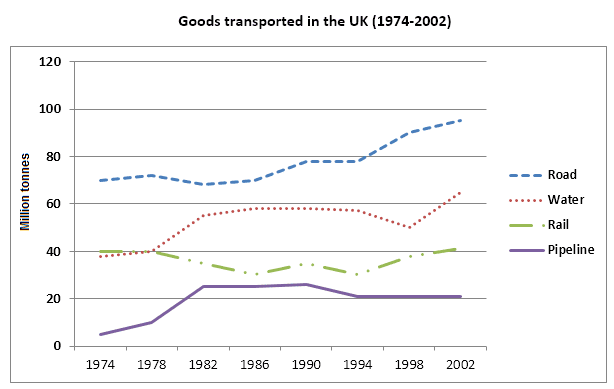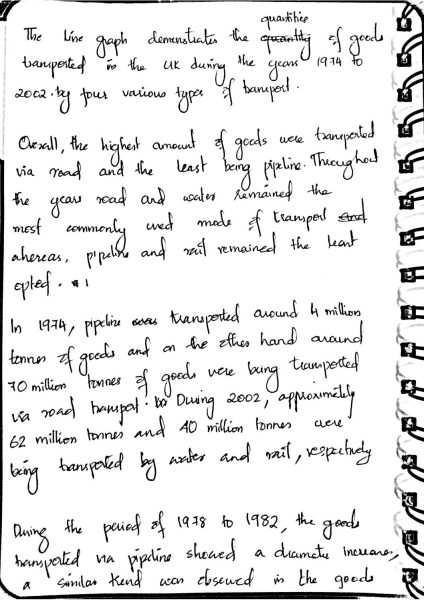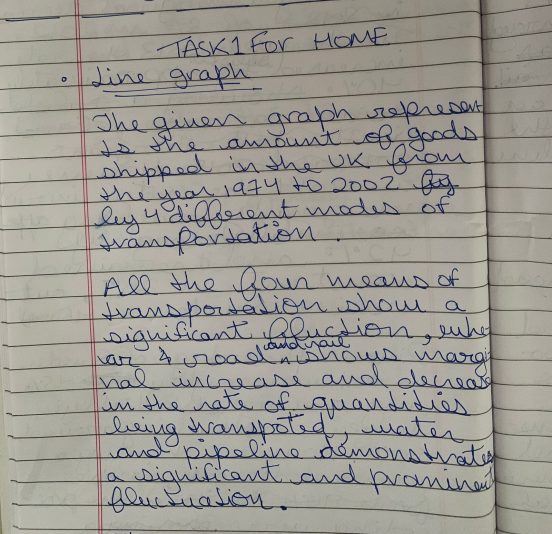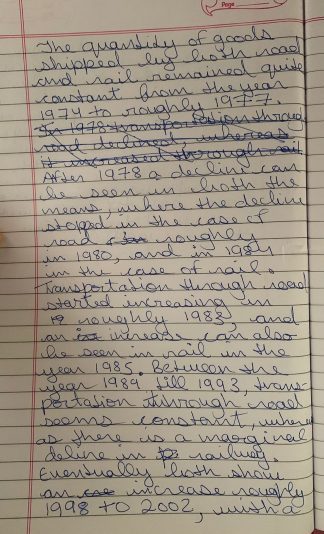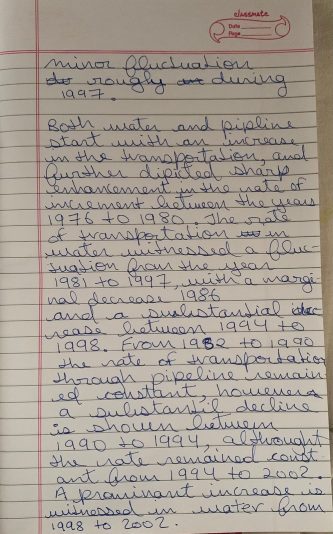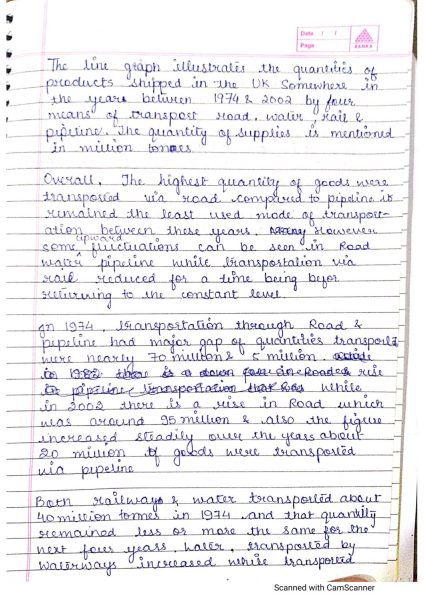-
Task 1 (Line graph : Goods transported)
Posted by Falak on November 29, 2021 at 11:30 AMThe graph below shows the quantities of goods transported in the UK between 1974 and 2002 by four different modes of transport.
Summarize the information by selecting and reporting the main features, and make comparisons where relevant.
Write minimum 150 words .
Falak replied 3 years, 4 months ago 29 Members · 56 Replies -
56 Replies
-
Unknown Member
Deleted UserNovember 30, 2021 at 10:46 AM-
The line graph demonstrate(s)
Always mention units (metric tonnes) in introduction
more than 70 million tonnes of goods are (were)
40 million tonnes was (were) transported
Be careful with word limit
Feedback : Great improvement . Try to focus on subject-verb agreement .
band : 2/3
-
-
Unknown Member
Deleted UserDecember 21, 2021 at 3:06 PMThe line graph illustrates the amounts of products shipped in the UK somewhere in the range of 1974 and 2002 by four distinct methods of transport namely road, water, rail and pipeline. The quantity is indicated in million tonnes.
Overall, the highest amount of goods was transported via road whereas pipeline remained the least commonly used mode of transportation over the entire period. Although there were some fluctuations, transport by road, water and pipeline showed an upward trend while transportation via rail reduced for a while before returning to the same levels.
In 1974, around 70 million tonnes of goods were transported by road and this quantity increased to about 100 million tonnes towards the end of the period. Pipeline transported 4 million tonnes of goods in 1974. This figure increased steadily over the years and in 2002, about 20 million tonnes of goods were transported using this means.
Both water and railways transported about 40 million tonnes of goods in 1974 and that quantity remained more or less the same over the next four years. Later, transport by waterways increased while transport by railways declined. During the period from 1986 to 1994, waterways transported around 60 million tonnes of goods. This quantity declined to around 50 million tonnes in 1998 and increased to about 65 million tonnes over the next four years. By contrast, quantity of transportation by rail declined to 30 million tonnes in 1984 and showed fluctuations until 1998 before rising again to 40 million tonnes in 2002.
-
Word count of the task is 251 words, try to concise the explanation.
A good task -1 can be easily achieved in 150-170 words.
Otherwise, well-written
Keep writing
Band: 2.5/3
-
-
Unknown Member
Deleted UserJanuary 14, 2022 at 1:51 PMThe line graph demonstrates number of goods in million tonnes transported in the UK during years 1974-2002 through 4 distinct ways road, water, rail, and pipeline.
In all transport, road is the most operated means of transport which had rapid increase during 1994-2000 reaching around 95 million tonnes starting from 70 million tonnes. After road, water, >then rail,>then pipeline are the most chosen one. Water and pipeline passage increased sharply during 1974-1982 however; there was not a consistent growth of both the passages during 1982-1994. Water transport increased from 38 to 62 million tonnes. Rail transport usage got gradually increased from 1994-2002 going from 30 to 41 million tonnes.
After 1978 there was a gradual decrease in the road transport till 1982 from 75 to 65 million tonnes. In water ways there was a sharp decrease during 1994-1998 from 58 to 45 million tonnes. In rail ways there was twice decrement during 1978-1986 then from 1990-1994. In pipeline, which is the least chosen in all 4 transports got a decrement in 1990-1994 from 25 to 20 million tonnes.
178 words
-
After road, water, >then rail,>then pipeline are the most chosen one. ( this format is not suggested)
After 1978 (,)there was a gradual decreased
In water ways(,) there was a sharp
1978-1986 then (than) from 1990-1994.
Overview is missing , in such case band score can’t go beyond band 5 in Task achievement. Make use of punctuation marks and adjust word count accordingly after adding overview.
-
-
-
You can mention measuring units (million tonnes) in introduction
well – written with grouping and comparison of data
Keep writing!!
Band: 2.5/3
-
-
Unknown Member
Deleted UserJanuary 26, 2022 at 8:25 PMThe given graph is a statistical representation of the things transported in the UK between 1974 and 2002 by four different modes of transport in million tonnes.
Overall, the road transportation has shown a steady increase, whereas the railway had fluctuations in its capacity of carrying goods. On the other hand, both water and pipeline have almost equal graphical representation with difference in the amount of goods they carry.
Although both pipeline and water transportation started from different quantities in 1974 which was 0 and 40 million tonnes respectively, still both of them rapidly increased till 1982 and from 1982 to 1990 pipeline goods carrying capacity remained constant. Simultaneously, the water route was also carrying the same amount till 1994. After 1990, the quantity slightly decreased via pipe and then again remained constant. On the other hand, water transport too showed a downward trend but then suddenly increased after 1998.
Considering the other two modes of transportation, road and rail. Although the road was already in heavy use carrying more than 60 tonnes in 1974, still the amount of goods transported by road was increasing every year with slight decrease in between and by the year 2002 the carrying quantity of things was touching 100 million tonnes. With all the fluctuations in railway goods capacity, in 2002 it remained there from where it had started.
-
both water and pipeline have almost equal graphical representation with difference in the amount of goods they carry. ( water and pipeline have shown different trends, we can’t infer any similarity between both)- overall is not accurate
different quantities in 1974 which was 0 (pipeline was never on zero rather around 5 million tonnes)
feature paragraphs should include more figures and data rather than just considering their trend.
Band: 1.5/3
-
-
The given line graph illustrates the information about the amount of quantity transported in UK by four various modes namely road, rail, water, pipeline in million tonnes from year 1994 to 2002.
Overall, it seems that the transportation by road, water and and pipeline has been increase over the years, while railway transportation shown the fluctuations.
In 1978, water and rail transportation has been transported same quantity which is 40 million tonnes but then use of waterways increase in next few years and transported more than 60 million tonnes of goods in year 2002.In other hand, transportation of goods by railway decreases after year 1978 and struggles to maintain their transportation of goods in further more years but in 2002 they transported over 40 million tonnes of goods.
The road transportation provides highest quantity in all year with its gradually increase trend, it also transported more than 80 million tonnes of goods in year 2002. After 1974, pipeline transportation has significantly increases quantity and transported 20 million tonnes of good in year 1982, then continued same till 1990 but from1994 transportation of goods decreases to 20 million tonnes and nealy same amount of goods transported in next 8 years.
-
the information about the amount of quantity (goods) transported in
has been increase (increased) over the years,
railway transportation (has) shown the fluctuations.
water and rail transportation has been transported same quantity ( water and rail transportation has transported same quantity)
but then use of waterways increase (increased) in next few years
In (On the) other hand, transportation of goods by railway decreases (had decreased) after year 1978 and struggles (struggled)
The road transportation provides highest quantity in all year (years)
pipeline transportation has significantly increases (increased)
nealy (nearly) same amount of goods (were) transported in next 8 years.
Feedback : Be careful with the tense usage ( indefinite and perfect tenses , understand the differences and rules)
Band: 1.5/3
-
-
The graph illustrates the quantities of goods imported in the UK using four different transport
modes namely Road, Water, Rail and Pipeline for the year 1974 to 2002
Overall, the road and water shipping type increased gradually over the period, while the product quantity of rail mode has fluctuations.
In 1974 the products transported in the UK through water and rail mode were nearly 38 million tones and 40 million tones. Water’s trend slightly increased to 58 million tonnes in 1982. During 1982 to 1994, the quantities of stocks were nearly 58 million tonnes and then slightly declined to 50 million tonnes in 1998. Then, there was a growth of nearly 12 million tones at the end of the year. In the meantime, the rail mode has fluctuations and reached 40 million tones at the end of the year.
In early 1974, 8 million tones stocks were transported in the UK through Pipeline mode and 70 million tones(highest among other shipping types) by road transport. The road’s trend increased steadily to 80 million tones in 1984 and reached 98 million tones(highest among other transport modes) in the end of the year. Meanwhile, the pipeline trend has 22 million tones in 1982 and remained steady until 1990. However, it slightly decreased to 20 million tonnes (lesser among other importing types) in 1994 and remained stable till the end of the year(2002).
-
The graph illustrates the quantities of goods imported in the UK using four different transport modes namely Road, Water, Rail and Pipeline for the year 1974 to 2002
Overall, the road and water shipping type increased gradually over the period, while the product quantity of rail mode has fluctuations.
In 1974 the products transported in the UK through water and rail mode were nearly 38 million tones and 40 million tones. Water’s trend slightly increased to 58 million tonnes in 1982. During 1982 to 1994, the quantities of stocks were nearly 58 million tonnes and then slightly declined to 50 million tonnes in 1998. Then, there was a growth of nearly 12 million tones at the end of the year. In the meantime, the rail mode has fluctuations and reached 40 million tones at the end of the year.
In early 1974, 8 million tones stocks were transported in the UK through Pipeline mode and 70 million tones(highest among other shipping types) by road transport. The road’s trend increased steadily to 80 million tones in 1984 and reached 98 million tones(highest among other transport modes) in the end of the year. Meanwhile, the pipeline trend has 22 million tones in 1982 and remained steady until 1990. However, it slightly decreased to 20 million tonnes (lesser among other importing types) in 1994 and remained stable till the end of the year(2002).
-
while the product quantity of rail mode has fluctuations.(while the products transported by rail had experienced some fluctuations)
In 1974(,) the products transported
through water and rail mode were nearly 38 million tones and 40 million tones (respectively)
Water’s trend slightly increased to 58 million tonnes in 1982. (and the quantity of stocks remained constant till 1994) During 1982 to 1994, the quantities of stocks were nearly 58 million tonnes
There is no requirement of putting facts in brackets, it can be included in the sentence itself.
Be careful with punctuation marks and try to reduce the verbosity of content using complex sentence structure. In feature paragraph 1, more grouping and comparison of data would have been appreciated rather than just explaining one mode of transportation.
keep writing!!
Band: 1.5/3
-
-
The Line graph illustrates how much goods were transported in the UK from 1974 to 2002 by various methods of transportation namely road,water,rail,and pipeline. The Quantities are measured in Million Tonnes.
Overall,Road was the most frequently used mode of transport for goods during the specified period, while pipeline was the least frequently used.There were fluctuations but Road,water,pipeline showed an upward trend while rail showed a downward trend initially but regained its position.
During 1974, Road Carried initially almost 70 million tonnes of goods and it climbed to 90 tonnes by 2002, while Rail carried initially about 40 million tonnes but it dipped to about 30 million tonnes and continued to fluctuate before settling at 40 million by 2022.
Pipeline began the year carrying about 5 million tonnes, climbed to 15 million tonnes by 1978, then to around 25 million tonnes by 1982, then maintained its position until 1990, when it dipped to 20 million tonnes and remained there until 2002.
-
The Line graph illustrates how much goods were transported in the UK from 1974 to 2002 by various methods of transportation namely road,water,rail,and pipeline. The Quantities are measured in Million Tonnes.
Overall,Road was the most frequently used mode of transport for goods during the specified period, while pipeline was the least frequently used.There were fluctuations but Road,water,pipeline showed an upward trend while rail showed a downward trend initially but regained its position.
During 1974, Road initially carried almost 70 million tonnes of goods and it climbed to 90 tonnes by 2002, while Rail carried initially about 40 million tonnes but it dipped to about 30 million tonnes and continued to fluctuate before settling at 40 million by 2022.
Pipeline began the year carrying about 5 million tonnes, climbed to 15 million tonnes by 1978, then to around 25 million tonnes by 1982, then maintained its position until 1990, when it dipped to 20 million tonnes and remained there until 2002.
-
There were fluctuations but Road,water,pipeline showed an upward trend (even water showed the similar trend)
but it dipped to about 30 million tonnes (in 1986)
“climbed” and “dipped” found repetitive with usage, can be replaced with “rocketed” , “dropped” respectively.
Keep writing!!
Band: 2/3
-
-
-
The line graph illustrates the goods transported in UK through different modes of transport namely Road, Water,Rail and Pipeline from year 1974 to 2002.
Overall, the road remains the major mode of goods transport in UK throughout the years whereas the water and pipeline modes showed a significant increase after 1978 but the rail mode of transport experienced a downfall after 1978 and remain steady till 2002.
In 1974, the goods transported through road was 70 tones whereas the goods transported through water was nearly 40 tones. Goods transported through road experienced a slight decrease after 1978 and it keeps on decreasing till 1982. After 1982, the share of road transport starts increasing and remains at top till 2002. On the other hand the goods transported through water increased sharply after 1978 , from 40 tones to around 60 tones in 1982. After that the share of water transport remains constant till 1994 and it decrease sharply from 1994 till 1998. During 1998-2002, the water transport experienced a sudden increase in the goods transport.
During 1974-2002 , the share of goods transported through rail remains the constant between the quantity of 30 to 40 tones. It showed a slight decrease in 1978 but becomes constant after 1990 and remains in the same range till 2002.
In 1974, the pipeline was the least preferred mode of transport of goods. It’s share was less than 10 tonnes. But it showed a sudden increase from 10 tonnes in 1978 to more than 20 tonnes in 1982. After 1982, it’s share in overall transport ofgoods becomes constant till 1990. After a slight reduction it’s share reduces to 20 tonnes in 1994 and remains the same till 2002.
-
it keeps (kept) on decreasing till 1982.
Need to select key features and make comparisons where relevant. Mentioning each and every detail can be troublesome to manage in 20 minutes.
-
-
The above line graph depicts the graphical data of goods transported in the United Kingdom from the year 1972 to 2002 through the different modes of transport used in that period i.e,road,water,rail and pipeline.
The interpretation of the graphical data shows us that the road transported 70 million tonnes of goods in 1974, it took a slight decrease in 1982 and increased to transporting upto 95 million tonnes of goods between the period 1986-2002.
Around 40 million tonnes of goods were transported through water in 1974-78, it increased to 55 million tonnes in 1982 and was constant till 1994. it took a slight dip in 1998 and shot up to 65 million tonnes in 2002. The railways transported 40 million tonnes of goods in 1974-78 and fluctuated between 30-40 million tonnes in the period 1982-2002.
5 million tonnes of goods were transported through pipeline in the year 1974 and rose from 10 million tonnes to 25 million tonnes in the period 1978-82. It remained constant till the year 1990 and decreased to 20 million tonnes in 1994, thereafter remained constant again in the period 1994-2002.
-
It is advisable to write overview after introduction , which will describe the trends
Answer is describing each transport with details, but the grouping and comparison of data is missing as question demands.
Band: 1.5/3
-
-
the above graph displays the information of the goods transported in the uk, from the year 1974 to 2002 by four various methods named Road,Water,Rail and pipeline. and the measuring units is mentioned in million tones
It can be seen that the highest amount of commodities transported was shown by land transportation which was around 70 million tonnes in 1974 to approximately 100 million tonnes in 2002. As a result, it can be stated as a huge improvement among other mentioned transportation.
similar increasing trend can be seen on goods transported by water and pipeline, they started just below 40 and about 5 million tonnes respectively and rose to just above 60 and above 20 million tonnes in the last year
An reverse trend can be observed for the goods transported using rail. In 1974, it was exactly 40 million tonnes and declined to about 30 million tonnes in 1984. It then showed a upside downside trend from 1984 to 1995. It raised its bars considerably until the year 2002 and reached its higher range at just over 40 million tonnes.
-
Overview is missing after introduction
An (A) reverse trend
More grouping and comparison data would have been appreciated.
Band: 1.5/3
-
-
Unknown Member
Deleted UserMarch 23, 2022 at 2:03 PMThe line graph illustrates the amount of Goods transported in the UK from the year 1974-2002, using different transportation methods road, water, rail and pipeline.
Overall, Since 1974 road is used to transport most amount of goods and pipeline is used as the least common way to transport the goods over the entire period. There were some slight fluctuations, transportation by road, water, pipeline showed gradual increase while transportation by rail showed gradual decrease.
In 1974 the amount of goods transported by road was 70 million tonnes and it steadily increased to 95 million tonnes by the year 2002. whereas, for pipeline the goods transported in the year 1974 was around 5 million tonnes and it showed an uptrend until 1982 and it become steady till 1994. There was marginal decline after 1994 and transported around 20 million tonnes of goods till 2002.
For rail and pipeline both started transporting 40 million goods in the year 1974.Water showed an uptrend while rail showed a downtrend till 1997 it was transporting around 35 million tonnes of goods which increased to 40 million tonnes by the year 2002, while water showed a fluctuation in the year 1998 but showed an uptrend in the year 2002 , it was transporting close to 65 million tonnes.
-
The line graph illustrates the quantities of goods transported in UK between 1974 and 2002 by Road, Water, Rail and Pipeline modes.The quantity is indicated in million tones.
Overall, the maximum goods were transported by road.The transportation of good by road was consistent and could see stable increase as compared to others. Transportation of goods over Pipeline mode seems to be less preferred during the given periods.
In 1974, around 70 million tones of goods were transported by road. There were fluctuations between 1974 to 1982 and later there was steady increase till 2002 and the supply reached close to 100 million tonnes in 2002 by Road.
Water and railways transported about 40 million tonnes of goods in 1974 and that quantity remained more or less the same over the next four years. There was decline by railways for eight years starting from 1978 whereas the waterways mode showed significant increase. Maximum amount of goods transfer happened in 2002 by Waterway and Rail and the number stands at 60 million and 40 million tonnes respectively.
Transfer by Pipeline mode showed steep increase from 1974 to 1982 and consistently around 20 million goods were transferred by this mode every year till 2002.
-
Transfer by Pipeline mode showed steep increase from 1974 to 1982 and (after that) consistently around 20 million goods were transferred by this mode every year till 2002.
Waterway and Rail and the number stands at (beyond) 60 million and 40 million tonnes respectively.
-
-
The line graph illustrates the amount of commodities transferred in the United Kingdom from 1974 to 2002 by roadways,waterways,railways and pipelines in million tonnes.In general,roadways served as the most commonly used mode of transport throughout the time period,while the least being pipelines.
In 1974 ,approximately 70 million tonnes of goods were transported via roadways,it increased to almost 80 milllion by 1990’s.However by the end of the time period,it had a substantial rise touching nearly 95 million.However,this was not the case of using pipelines as a mode of transport.Starting at approximately 5 million tonnes by the start of the time period,it had sharp rise to almost 25 million by 1990’s and dipping to 20 million by 1994 and showing a stagnant growth till 2002.
In 1974 ,starting at almost 40 million tonnes of goods transported via waterways and railways, waterways became more popular by 1978 and had a more gain of almost 24 million tonnes surpassing railways in 1990.By the end of the time period,almost 70 million tonnes of goods were transported via waterways and nearly 40 million tonnes of goods found its path through railways.
-
The above mentioned graph illustrate the goods transported in the UK by four different modes of transportation between 1974 to 2002.
Overall, million tones of goods commute through Roadways, Railways and Pipeline. For some extend they also uses Water transportation. Therefore, they have some fluctuation between different source of transport.
An interpretation reflects a modest increases from 65millions to 98millions between 1974 to 2002 through Road services. However, in 1974 quantity of goods stated 40 millions via Water and a consistent flow between 1978 to 1982 with 55 millions or more with slightly rise up to 60millions . In 1998, there was a gradual fall from 60 millions to 50millions , but we can see such a modest up between 50millions to 65millions between 1999 to 2002.
However, We would see the a gradual ups and down from 40 millions to 30 millions between 1974 to 1986 and a constant ups and down till 1998 through Rail and Pipeline.
-
mentioned graph illustrate(s) the goods
they have some fluctuation(s) between different
reflects a modest increases (increase)
quantity of goods (transported) stated 40 millions
Try to maintain the tense throughout (I would suggest past tense in this graph )
Make use of varied cohesive devices and sentence structures.
keep writing!!
-
-
The line graph illustrates the quantities of goods that were transported in the UK by different modes of transport from 1974 to 2002.
Overall, the highest quantities of goods were transported by road and the least being transported by pipeline . In spite of some fluctuations, the transportation by road, water, and pipeline saw some progress while no such progress was seen in the case of transportation by rail.
There was a significant increase in the quantities of goods being transported by road from 1974 to 2002. About 70 million tonnes of goods were being transported in the year 1974 whereas in 2002 it was close to 100 million.
From 1974 to 1978 the quantities of goods transported by water and rail was 40 million tonnes. However, from 1982 to 2002 transportation by water saw a steady growth, whereas transportation by rail saw a significant dip from 1982 to 1998 before reaching it’s original position in 2002
The least used mode of transport was the pipeline which pretty much explains why it was off to a slow start in 1974. However, from 1978 to 2002 a significant growth was seen in the quantities of goods being transported by pipeline. Keeping aside the quantity, this growth is comparatively better than the “no progress” seen in the rail.
-
Clear progression , comparison of data can be clearly observed. Mention the units of measurements in introduction itself
Keep writing!!
Band: 2.5/3
-
-
Unknown Member
Deleted UserMarch 29, 2022 at 5:13 PMThe given line graph illustrates the amounts of items which were delivered within the UK by using four different means of transportation, from 1974 to 2002 via road, water, rail and pipeline . The unit of measurement was ton. Overall, it can be seen that the roads were used the most and pipelines were used the least throughout the period.
To begin with, in the initial year(1974) ,70 million goods were transported through the roads while pipelines transported just around 5 million. In this year, water and rail routes were used to transport around 40 million goods and this figure remained more or less the same for the next 4 years. After that, the quantities of goods which were moved using roads and pipelines increased till the end of span, though some fluctuations can be noticed. In 2002, the figure for roads and pipelines was of around 100 million and 20 million respectively.
By contrast, after 1978 rail was preferred less and hence it transferred about 30 million products for the next 20 years. But ,in 2002, this figure reached just above 40 million. While , water ways gained popularity and nearly 60 million products were transferred by its use. However, in 1998, this quantity declined and reached to 50 million but in the next four years it rose to approximately 65 million.
-
The graph represents the data of goods shipped in million tonnes to the UK from 1974 to 2002 by four various means of transportation which are rail, water, road and pipeline.
Initially, pipeline, water and roadways were used the most to transport goods but they were constantly fluctuating with ups and downs in their usage as a means of shipping items. Whereas, Railways was the least used transport of them all and mostly showed a downward trend.
From 1974 to 1982 pipeline and water began with a slow growth and somewhere near 1978 had an exponential push in the trend. In comparison to pipeline and water, road and rail didn’t have much change in the graph but after a few years, it decreased. Later on, till 1998 water and pipeline maintained a steady growth while rail and road were continuously had variable growth.
In conclusion, road was the most used means of transportation with highest growth at the end years. Water was second to road and saw an amazing increase throughout while rail started off with water but had huge fluctuations in the whole tenure. The least used transport was pipeline which increased for a while then maintained a constant growth.
-
The graph represents the data of goods shipped in million tonnes to the UK from 1974 to 2002 by four various means of transportation which are rail, water, road and pipeline.
Initially, pipeline, water and roadways were used the most to transport goods but they were constantly fluctuating with ups and downs in their usage as a means of shipping items. Whereas, Railways was the least used transport of them all and mostly showed a downward trend.
From 1974 to 1982 pipeline and water began with a slow growth and somewhere near 1978 had an exponential push in the trend. In comparison to pipeline and water, road and rail didn’t have much change in the graph but after a few years, it decreased. Later on, till 1998 water and pipeline maintained a steady growth while rail and road were continuously had variable growth.
In conclusion, road was the most used means of transportation with highest growth at the end years. Water was second to road and saw an amazing increase throughout while rail started off with water but had huge fluctuations in the whole tenure. The least used transport was pipeline which increased for a while then maintained a constant growth.
-
Initially, pipeline, water and roadways were used the most (majorly) to transport goods
From 1974 to 1982 (,) pipeline and water
road and rail didn’t have much change in the graph but (in fact) after a few years, it decreased.
There is no need to mention conclusion in Task 1 , rather talk about this analysis in overview and do mention “overall” in that.
Keep writing.
-
-
The given line graph depicts the quantities of goods that were transported in the UK by various means of transport from 1974 to 2002.
Overall,the quantities of goods that were transported by road was the highest where as the least was transported by pipeline.
To start with,there was a constant increase in the goods being transported by means of road between 1974 to 2002. The quantities of goods transported by road increased from 70 million tonnes to 98 million tonnes.
The goods transportation by means of water and rail were almost same in 1974 which was 40 million tonnes. However,in case of transportation by water, the trend varied between them in the further years , there was a surge from 1978 to 1982 and remained constant up to 1994 and then decreased and again increased to 62 millions . On the other hand ,there was a reduction in transportation by means of rail from 1978 to 1994 and then picked up and reached to 40 million tonnes again.
The means of transport that was used least was pipeline , in spite of that there was a quite good pick up from 1974 to 1982 and then remains same up to 1990 and again dropped in 1994 to 20 million tonnes which was same up to 2002.
-
Do mention units of measurements in the introduction itself
where as (whereas) least was (were) transported
repeated use of expressions , phrases has been observed. More comparison of trends could make writing even more effective.
Band: 1.5/3
-
-
The given line chart indicates a million tonnes of goods being transported in the UK through various channels namely road, water, rail and pipeline from 1974 to 2002.
It is clear that goods transported through roadways have shown an increase in trend over the period. Despite some fluctuation in tonnes of goods being sent through rail and waterways, there was a steady increase, which is continued till 2002. It is obvious that pipeline is the lowest among the 4 modes of transport.
In 1974, 70 million tonnes of goods were transported on road. This figure then shows a steady increase and reached a peak of just over 95 million tonnes in 2002. Waterways recorded the second largest with 65 million tonnes of goods during that period, with the only exception in 1974 when it had 38 million tonnes transported and overtook railways in 1978.
Additionally, the trends for railways in 1974 and 2002 were similar showing 40 million tonnes, although there was a slight fluctuation in the number of goods being transported between 1978 to 1988. Transportation via pipeline is the least which touched an all-time low in 1974 and hovers around 20 million tonnes from 1980 to 2002. All in all, Roadways are the most preferred mode of transportation within the given period of 28 years.
-
it is advisable to write “Overall” while giving overview
Despite some fluctuation in tonnes of goods being sent through rail and waterways, there was a steady increase, which (and It) is continued till 2002. (combination of complex-compound sentences which requires two independent clauses at least, hence which is replaced by “and It”)
be careful with punctuation while framing complex structures.
Keep writing!!
Band: 2/3
-
-
The graph shows the quantities of goods transported in the UK between 1974 and 2002 by four different modes of transport, namely road,water,rail and pipeline.The quantity is indicated in million tonnes
As we can see the Road and Water modes have been able to transport goods not less than 40 million tonnes from 1974 onwards which has only been ever on a gradual rise.By 1990 the Road mode has touched the 80 million tonnes mark which it crossed during the period of 1998.However in the water mode we see a downtrend during the 94-98 period where the goods transported changed from 60 million tonnes to 50 million tonnes.
Coming to the rail and pipeline modes which has ever barely crossed the 40 million tonnes mark during the whole period till now. As the rail mode shows us a almost straight line graph without much fluctuations and moving always close the 40 million tonnes mark
Now in the pipeline mode we see a gradual increase from 0 to 30 million tonnes in the 1974 to 1984 period which now comes to almost a straight line moving always close the 20 million tonnes mark for the remaining period.
-
which has only been ever on a gradual rise. ( road was not only on rise, In 1982 , it suffered a dip )
.However(,) in the water mode
Coming to the rail and pipeline modes which has (have) ever barely
“Overview” is missing
Make use of punctuation , in order to make writing more readable
Band:1/3
-
-
The line paragraph demonstrates the information about goods transported in the U.K. from the year of 1974 to 20002 through various modes like water, rail, road, and pipeline. in million tones.
Overall, the study shows goods transported through various modes was drastically changed through the years of 1974 to 2002.
Initially, in 1974, 40 million tones of goods transported in the U.K. through rail and water. In 1978, the goods transported by water was slightly increase up to 60 million tones then it remain stable till the year of 1994. it has risen suddenly in 2002 above 60 million tones .Meanwhile goods conveyed through rail was dramatically fall below 40 billion tones. it has consistently fluctuate till 1998 and has sharply incline to 40 million tones.
we also can see that goods transported via pipeline was sharply decrease to 0 billion tones in 1974. and it remain constant. also goods transferred through road was also subsequently gained above 80 billion tones in 1994 to 2002. goods transported though road was consistently fluctuate between 60 to 80 million tones in the year of 19974 to 1994.
-
The line paragraph (graph) demonstrates
overview is not fully developed. It is not highlighting any specific trend
it remain (remained) stable till the year
goods conveyed through rail (dramatically fell) was dramatically fall
it has consistently fluctuate(d)
has sharply incline(d)
it remain(ed) constant.
Tense should be maintained throughout
-
-
The line graph illustrates the goods transported in the United Kingdom from 1974 to 2002 by modes of road,rail,water and pipeline transport.
Overall, the transportation of goods through road and water show a steady and significant rise over the period while the tonnes of goods by rail show the fall and steady trend but by pipeline,it shows a rise and steady trend.
As you can see the goods transported by road and water shows a steady rise throughout the period, while the tonnes of goods transported by rail and pipeline experienced a steady.
In early 1974 the tonnes of goods by road is 70 million tonnes.This was the highest among the others.However it dramatically declined to 65 million tonnes in 1982.Then there was a growth to 79 million tonnes in 1990 but it was grown to rise over the period. Although there was a steady rise and fall in the pipeline as it rose to 25 million tonnes in 1990 and fall to 20 million tonnes in 2002
-
do mention units of measurement in introduction.
In overview, the word ” steady” has been used repeatedly, especially at places where it is not even required.
Body paragraph 1 is not effective , as it does not include any data and figures. Moreover, the sentence structure is also a point to consider.
Tense should be maintained through out.
Band: 1/3
-
-
The line chart illustrates the Goods transportation by the mode of Road, Water, Rail & Pipeline in the UK for the period between 1974 to 2002 in Million tones.
Overall, the goods transported through pipeline have shown some decline from the Strat of the year 1974, then it fluctuate till 1994 and remain constant till 2002. meanwhile goods transported by roadways have risen in 1994.
From 1974 to till 1978 Good transported by water and Rail was about 40 Million tones, but it was observed that from 1978 goods transported by water and Rail are moving in the opposite direction. From 1978 to 1982 goods transported by water was dramatically increased to 60 million tones. It was continued till 1998, and in 2002 we can observe that it was crossed 60 Million tones mark. Whereas goods transported by Rail was sharply decrease from 40 million tones to 30 million tones from 1978 to 1986, and same was continued till 1994.
The movement of goods by road & pipeline was different. Goods transited through pipeline was between 0 to 20 million tones in the year of 1974. But in the year of 19982 it was slightly increased above 20 million tones it remain stable till 1994, and then it stopped on 20 million tones till 2002. The goods conveyed through roadways has shown drastic changes. it was steady between 60 million to 80 million tones in the year of 1974 to1994, but after that it was suddenly raised above 80 million tones till 2002.
-
The four given line graphs show the quantities of good transported by the four different modes of transport during the year 1974-2002 in the UK.
Overall,it is clearly seen that,through road transportation the highest quantities of good were deported during the above years while water transportation being second,rail transportation being third and pipeline transportation being fourth in transporting the goods during the above period.
In the year 1974,around 5 million tonnes of the goods were transported by pipeline which was gradually increased to 25 million tonnes by the year 1982 and then it was eventually decreased down to around 20 million tonnes by the year 2002 whereas approx. 40 million tonnes of good were transported by rail during the years 1974-2002 while the amounts of goods transported by the water has seen a gradual increase and then decrease and then increase during the years 1974-2002 from around 40 million tonnes to around 60 million tonnes whereas the highest quantities of goods were transported by road as compared to the other modes of transportation from approx. 70 million tonnes in the year 1974 to around 100 million tonnes by the year 2002.
-
The four given line graphs ( The given line graph), there is only one line graph
Paraphrasing could have done effectively, avoid copying the language from the question
of good(s)
There should be two feature paragraphs. Comparison among different parameters is missing.
Keep writing!!
Band: 1.5/3
-
-
The graph below shows the quantities of goods transported in the UK between 1974 and 2002 by four different modes of transport.
The line graph showcases various methods used in transportation of goods in million tonnes in the UK for a time-span of 28 years.
Overall, there were 4 modes; Road, water, rail and pipeline. Water and Rail transportation delivered same of goods at the beginning but Rail became less common and sea delivery increased significantly. Road transportation kept on climbing while pipeline method made a steady increase.
At the start of the year Road transport was at peak delivering nearly 70 million tonnes whereas Pipeline was least used delivering <10 Million tonnes. Water transport was an instant hit capturing 50% of the market in less than 10 years whereas Rail lost its popularity over the years only to regain its 40 million tonnes market share at the end of the 2002.
All the methods utilized for delivery made a significant rise over the span of 3 decades. Road transport never really lost its popularity and held the prime spot whereas waterways and Pipeline had their own ups and downs.
-
-
-
water, water transported by waterways increased while transported – sentence is not clear
60 million tonnes of good(s)
the quantity decline(d)
avoid writing “&” instead use “and”
avoid repetition of words like” transportation”
Keep writing!!
Band: 2/3
-
Log in to reply.

